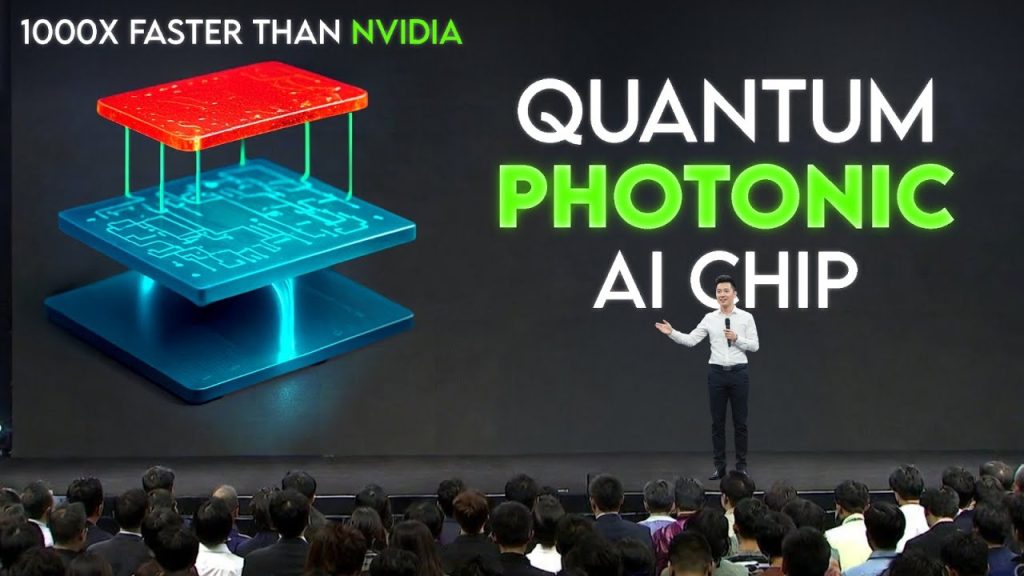China Unveils Photonic Quantum AI Chip: 1000 Times Faster Than NVIDIA.

A Revolutionary Leap in AI: The New Photonic Quantum Chip
The landscape of artificial intelligence is experiencing a startling shift, with a Chinese research team making headlines by introducing a groundbreaking quantum photonic chip. Unlike the conventional imagery of quantum computers locked in high-tech labs, this innovation is ready to operate within everyday data centers, potentially transforming industries overnight.
The Breakthrough: A Game-Changing Chip
This innovative chip emerged from a collaboration between Chip X (Chip Hub for Integrated Photonic Explorer) and Touring Quantum. Together, they’ve engineered what they claim is the world’s first truly scalable industrial-grade optical quantum chip. The compact size of this technology, built on a 6-inch thin film lithium niobate wafer, is particularly noteworthy—it integrates over a thousand optical components onto a single slice of silicon, emphasizing the importance of photonic integration.
The Science Behind Photonic Computing
What sets this chip apart is its use of light as the medium for qubits and computation, rather than traditional electrical signals. This shift creates significant advantages:
-
Heat Generation: Light generates far less heat than electricity, which helps mitigate overheating—an essential consideration for data centers already grappling with power consumption issues.
-
Space Efficiency: Photonic chips require less physical space, making them more adaptable for current infrastructures.
-
Speed and Efficiency: Photons are faster and lose less energy during transmission, resulting in quicker, more efficient data movement.
These characteristics are attracting many researchers to photonics as a solution to the growing challenges faced by data centers, particularly in training AI models.
The Claims and Reality Check
While the projections regarding this chip’s performance are remarkable—suggesting a thousandfold speed enhancement over Nvidia GPUs for specific AI tasks—it’s essential to temper expectations. Reports indicate that while the chip excels at particular applications, such as those benefiting from quantum-style parallelism or ultra-low latency photon pathways, it isn’t universally faster across all workloads.
Scalability and Deployment
One of the critical obstacles in quantum computing has been the complexities involved in building and calibrating systems, often requiring months of setup. However, Chip X claims that their photonic design can reduce this timeline dramatically. Systems that traditionally need six months for assembly can now be operational in just two weeks—an incredible feat for technology at the forefront of quantum computing.
While this does not reach the capabilities of a full quantum computer—one that might break encryption or perform other advanced functions—it establishes a strong foundation for high-speed AI and data processing. Essentially, this chip acts as a programmable photonic accelerator, leveraging properties of light in an integrated design.
Recognition and Production Capabilities
The innovative design attracted significant attention, earning the team the leading technology award at the 2025 World Internet Conference in Wuhan, where they faced over 400 global ventures from 34 different countries. This accolade suggests that China is becoming a serious contender in the field, especially concerning production capabilities.
Chip X has initiated a pilot production line capable of producing 12,000 wafers per year, yielding roughly 350 chips each. Although this volume is modest by semiconductor standards, it represents a strong early achievement in the field of quantum classical photonic chips.
Industrial Applications
Current applications focus on industries that rely heavily on computational speed and efficiency, such as aerospace, biomedicine, and finance. These sectors are often early adopters of technology, eager to alleviate computational bottlenecks, making them ideal candidates for this new quantum photonic chip.
The ease of integrating these chips, given that they don’t require exotic cooling methods, means they can be seamlessly incorporated into existing data centers without significant modifications.
Co-packaging Technology: A Technical Advancement
A pivotal aspect of this new chip is its advanced co-packaging technology, which locates both electronic and photonic components side-by-side on the same wafer. This proximity leads to reduced latency, lowered noise, and significantly increased bandwidth.
The monolithic design allows for a compact arrangement where photons have minimal distance to travel, consequently enhancing throughput by minimizing error rates. This kind of optimization embodies what we’ve seen in sophisticated classical chips, now adapted to exploit the physical principles governing photonics.
Global Context: The Quantum Race
China’s announcement arrives at a critical moment. While countries like the US, various European nations, and major tech players, including Google and IBM, are exploring their paths in quantum computing, none have locked down a clear advantage. Each region appears to be placing a bet on different technologies—be it superconducting qubits or silicon photonics—while China advances with thin film lithium niobate.
By establishing a functioning production line and deploying chips, China appears to be setting a new pace in the global quantum race. Their framing of this achievement as the first industrial-grade optical quantum computer hints at an intent to weave this technology into mainstream data center operations alongside GPUs and specialized AI accelerators.
The Future Landscape of AI
As these developments unfold, we are on the brink of a potential paradigm shift in computing. A hybrid system may emerge, where photons manage demanding computation while traditional silicon maintains other essential processes.
While Nvidia GPUs will likely continue to play a significant role in the computing ecosystem, the introduction of photonic chips opens avenues for addressing rising power consumption while enhancing performance.
As the story of this technology continues to evolve, the next few years could be transformative for industries that rely on advanced computational capabilities.
Conclusion
The advancements made in quantum photonic technology are reshaping our expectations and the realities of data processing. With the potential for substantial speed and efficiency improvements, this breakthrough could redefine how industries tackle complex computational challenges. As we continue to monitor these developments, the balance of power in quantum computing will undoubtedly be worth watching.
Feel free to share your thoughts and insights! Sign up for updates if you’re interested in more deep dives into AI and quantum technology. Thank you for joining us on this exploration!
#China #Shocked #World #Photonic #Quantum #Chip #Faster #NVIDIA
Thanks for reaching. Please let us know your thoughts and ideas in the comment section.
Source link





can they hurry up im so bored
😮
Ah, now I get why they all come to study in Dresden =/….
BS!!!!!!!!!!!!!!!!!!!!!
sounds like regular ccp bullshit, again
Wow, you are keeping busy following all the news and reports.
Bingo… Holographic Memory built into it. That's going to go very very far.
Mind-blowing to think how powerful computers going to be in 5-10 yrs time
Bla bla bla
Lies lies lies
Bring in my lasers.
Good news for the bubble.
I was expecting that Google will take The Lead with the Willow Quantum Chip…
Vaperware the chineese do nothing but copy and steal others work
At what point does self-improving iteration take off? Too bad Google hasn't figured out how to use that mystery quantum channel as AI food. I suppose it will take a self-improving AI to break that barrier.
90% of the news that comes out of China is COMPLETELY FAKE NEWS. Co-Packaged Optics is not new, and China is certainly NOT ahead of anyone else and are in fact far far behind the market leaders like Broadcom
Meanwhile in USA they are building hundreds of data centres (that use more electricity than an entire city) that are obsolete even before they are built. LOL, smart move. They invested their entire economy into it instead of waiting just a single year from proper, clean tech, which was inevitable to develop with AI. They just failed to see that. Heck, they are probably still deluding themselves just to justify their stupd mistake.
Goodbye, NVidia. It's been a fun ride. We won't miss you.
…if it's legit then crypto is cooked… prove it…I wish them well…
As with a lot of news out of China: But are they LYING?
There is a US based company called Xanadu that is building a quantum Photonic chip-based quantum data center.
A YouTuber called Anastasia in Tech has the details in her video.
https://youtu.be/HnsbSdb-9h8?si=S_sJgkGZ1o3eMk11
They don't have a legit provable claim that can be verified, downvoted for this garbage.